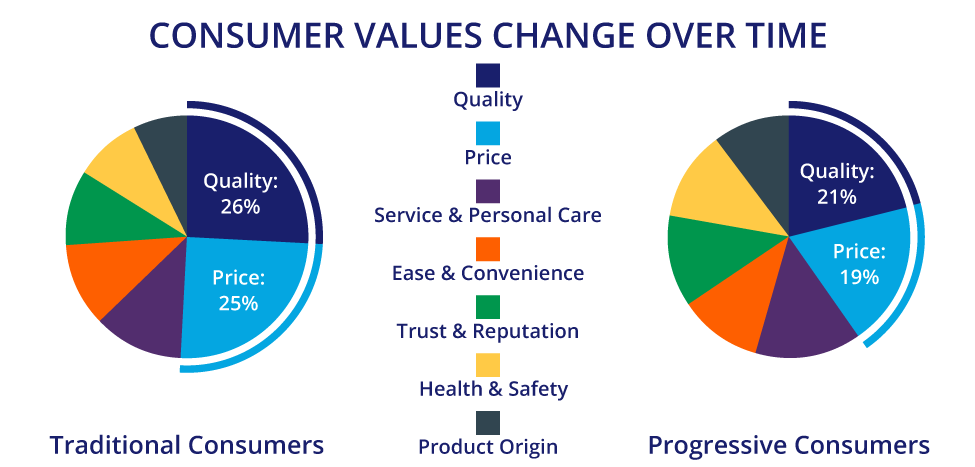Can Branding and Identity Design Take Your Business to the Next Level?

Does your business have strong branding and identity design? This aspect of your marketing strategy is more important than you might realize. In fact, it serves as an essential foundation for connecting with buyers.
Your brand embodies your business, what it offers and what it’s all about. Building an effective brand is essential to creating an overall marketing strategy. However, many different elements go into doing so, and you can’t overlook key details. Understanding the importance of branding, the steps you need to take and the challenges you’ll have to overcome can situate your business to develop powerful branding and identity design that grows your business.
But first, what’s the difference between branding and identity design?
If your brand is the intangible elements of your business, like how people perceive it or its values, brand identity is the elements we see, hear, touch and, in some cases, smell. Those pieces trigger the first level of audience connection through the five senses.
Branding, the often misunderstood piece of the marketing puzzle, is the strategy that distinguishes a company or product from the sea of competition. It’s how a brand reaches its target audience, finds success and attracts market share.
Without a brand identity, branding is disjointed and ineffective. Without branding, a brand identity is a cluster of pixels and fonts.
Why your company needs branding and identity design
Let’s explain why branding and identity design are essential to your marketing strategy. Neither one is something a successful business leader can dismiss and leave to chance. Instead, taking control and defining a cohesive brand strategy is crucial to developing a solid foundation for your marketing efforts.
Your brand is an asset
You must develop your brand the same way you would any other asset by making it something that supports your business goals. Developing your brand is a major part of your overall digital marketing strategy. This might seem wasteful without the immediate return that other investments can have. However, well-established companies across many industries make branding and identity design one of their top priorities because they realize the long-term impact it can have on ROI for all marketing efforts.

Standing out in the marketplace
Growing your business means successfully guiding more customers through the customer journey—the series of interactions a customer has with a brand as they progress from a prospect to a client to a loyal advocate. The first step in that journey is building a recognizable brand to capture the attention of potential customers and generate brand interest. This is a considerable challenge in many sectors, depending on the number of competitors and the depth of their marketing budgets.
Your brand identity helps you stand out online. That first impression is vital, as most consumers quickly decide whether to try out your brand. One aggregated sales lead data study showed that 84 percent of conversions occur on the first website visit. You need to make a strong impression to convert customers before your competitors.
Build an emotional connection
Bringing in and retaining customers isn’t just about the hard facts of your product or service. Instead, it’s more often about the emotional connection you build with your customers and the public in general. Giving your clients a brand experience plays a key role in creating that connection.
Your brand is the aspect of your business that customers engage deeply with. Without an effective strategy to develop and maintain that identity, you’re missing out on the emotional connection that can drive your company’s continued growth.
Build credibility and trust
Consumers need to be able to trust the companies they do business with. They need to know that your company really delivers what it promises. This is true not just about your products or services but about less-tangible elements of your business as well, such as fairness, reliability and values.
Developing a brand that instills credibility and trust can make it easier to gain new customers, retain existing customers and have them recommend your business to others. In a recent survey, more than 80 percent of consumers responded that trust is a deciding factor in their purchasing decisions.
What goes into your branding and identity design
Now that the importance of branding and identity design is clear, a closer look at the critical elements of building your brand is in order. Developing a personality for your brand, creating a visual identity and maintaining consistency across your market efforts are all essential steps.
Developing your brand’s personality
Understanding your target audience is one of the key factors in strategically formulating your brand’s personality. Who are your potential customers, and what do they care about? Does an exciting, sincere or sophisticated brand appeal to them?
Presenting your brand’s authentic personality clearly and consistently to a market segment that aligns with it is critical to building genuine connections. If unmanaged, your brand’s personality becomes inconsistent, irrelevant or worse, repelling. Preventing this requires careful brand auditing, development and refinement.
Designing the visual identity of your brand
Your brand identity includes several visual elements and messaging. Of course, you have your logo or family of logos, but additional components such as taglines and slogans combine messaging with design. A brand standard guide lists your corporate colours and fonts while establishing design layouts for your online and offline marketing efforts—such as letterhead, ads and social media content—and how to use them.
Those visual elements are vital to a strong first impression for your brand and establishing a recognizable identity. You want your potential customers to know immediately when a product or service is coming from you. This helps established customers find you among your competitors and catches the eye of new customers.

Maintaining consistent branding and identity design across channels
Keeping your branding consistent across all channels and platforms makes it stronger. Consistent branding means potential customers recognize your business through any contact point, making the customer journey more seamless. For each customer touchpoint, you have many different channels to consider, including your website, email marketing, offline marketing and all the ways you can reach customers on social media. Maintaining a coherent style and continuity across channels is more effective than having different designs for each one. Companies with consistent branding across platforms can increase revenue by up to 23 percent.
Your branding and identity design, your story
Now, let’s go over the elements of branding and identity design that go into making your brand your own. Following a cookie-cutter branding package with ad hoc design is not enough. Instead, your business must ensure unique and relevant branding by adhering to a clearly defined strategy.
Telling your story
Branding serves as an excellent opportunity to communicate your story with potential customers. The right strategy can shape the narrative around your brand. Your company’s history, mission, values and goals are all essential elements of branding that you must carefully develop around your unique business.
This kind of storytelling is highly valued by consumers today. They want a real connection, not just a product off the shelf. In a consumer survey by Stackla, 88 percent of consumers said authenticity is a top factor in choosing brands. You need this to shine through in your branding.
Representing your business values
Your brand gives potential customers insight into who you are and what you offer. Reflecting your values and mission is important to communicate information about services and your business as a whole. Today, more and more consumers are considering these factors in purchasing decisions.
In fact, shared values are one of the principal decision-making factors for consumers today. A survey of more than 7,000 consumers by the Harvard Business Review showed that 64 percent put shared values as the top reason for long-term brand relationships. Your branding needs to let your customers understand your values.
Considering the competition
Your business doesn’t exist in a vacuum. To compete in the modern landscape, you need an acute awareness of how your competitors handle their branding and identity design. What are they doing that you should try to do better? Where are they leaving opportunities unrealized?
Careful analysis of competitor branding is crucial when planning your brand strategy. Your competitors have already put a lot of work into understanding their market. You can draw valuable insights by looking at what they’re already doing and spotting where they’ve left untapped prospects. This requires the fine-tuned expertise that only professional marketing support can provide.
Capturing the evolving consumer landscape
Long-term brand principles and current consumer trends will guide your branding and identity design details. Trends are loved today but will be forgotten tomorrow, so your branding must be relevant when you establish it and have staying power.
No matter what industry you’re in, there are always new trends. Identifying these trends and making the right strategic moves for your brand can let your business seize the opportunity rather than falling behind the competition.

Branding and identity design challenges
Do you know what to expect once your branding and identity design is underway? Your business might face a few challenges and roadblocks during the process. How you handle these challenges can make or break your brand.
Not sure where to start?
If this is the first time you’ve sat down to consider your brand strategy, then chances are you’re already feeling overwhelmed. There are so many elements to consider, all highly interconnected. The task ahead can seem truly monumental at first.
This is where a professional marketing agency can make an incredible difference. Instead of progressing through trial and error, they build your branding and identity design on a solid foundation of market research, consumer understanding and the insight to correctly present your business.
Lacking an overall strategy
It’s also important to note that branding and identity design is just one part of your overall marketing strategy. Branding is something that impacts all other aspects of your marketing and sales. Working with a professional agency to develop a comprehensive marketing strategy ensures these elements synergize rather than clash.
Developing brand guidelines is one example of how professional support can help. Just 25 percent of companies have formal brand guidelines, often leading to ineffective marketing efforts. You can ensure that all of your marketing materials present a unified front, now and in the future.
Trying to handle it in-house
Many tools out there promise to streamline branding, and that has some businesses trying to handle brand strategy in-house. Online logo generators have been around for years, and the onset of new AI tools may seem like a promising way to facilitate branding.
However, these tools don’t provide the overarching branding and identity design that goes into creating consistent and impactful marketing for your organization. Instead, you’ll put your skilled team to work in an area where they don’t have the specific expertise to deliver results. When you avoid seeking outside help, you consume more business resources with little to show.
Three reasons to get started now
1. Branding and identity design are essential to the growth and success of your business
Your brand makes you stand out and helps you connect with your potential customers. That’s why your business needs to invest the time and resources to make your brand the best it can be. Implementing that requires careful planning and execution. Your brand needs a defined personality that shines through in messaging and visual design. That personality must also find its way into your marketing efforts across all platforms.
2. Building your brand won’t deliver benefits unless it truly represents your business
Branding and identity design should help you tell your story and communicate your company’s values with potential customers. It requires a careful balance of understanding your company, your competition and your customers.
3. Branding and identity design can help boost your business, but not if you’re using cookie-cutter, DIY tactics
If you’re trying to handle your branding and identity design in-house, you may not be taking the best approach. Knowing where to start, developing an overall strategy, and the specific skills involved are all areas where your team and business would be better off leaving it to the professionals.
So what’s the state of your company’s brand?
The buyer journey starts with grabbing a prospect’s attention and generating brand interest. Is this a considerable challenge in your industry? Do many companies compete for the same customer? Do your competitors have larger marketing budgets? Getting your brand strategy and identity right is even more critical if you answered yes to any of these questions.
Does your brand personality elicit a positive emotional response from your target audience? If it doesn’t, you’re missing out on important connections, clients and referrals; it’s time to audit and refine your branding.
When you review your website and other marketing materials, are your company values evident? If not, you’re limiting your long-term customer relationships.
There’s a lot to consider. However, there’s no reason why your business needs to undergo the journey alone.
Are you ready to build your brand?
At Mindspin, we understand just how serious these challenges can be. However, we also have the unique insight and experience to overcome them. Maximize the impact of your branding and identity design by trusting them to the professionals.
Whether your startup is at ground zero or your established business needs a brand experience audit to guide your brand evolution, we bring leadership, expertise and insight to the partnership. Mindspin Studio provides branding and identity design services that build a strong connection with your audience and a solid foundation for your marketing program.
Share this article with a colleague who is struggling with branding.
Tanja Groos, Founder and CEO, Mindspin® Studio Inc.
Tanja Groos is CEO Mindspin with more than 20 years of experience in branding and digital marketing. Her work has been published and awarded. Her leadership has tripled sales within a year, surpassed top industry competitors online, and enhanced brand credibility for her clients.
Follow Tanja on LinkedIn












